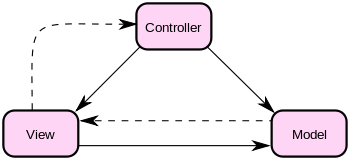Use of the Model/View/Controller (MVC) pattern results in applications that separate the different aspects of the application (input logic, business logic, and UI logic), while providing a loose coupling between these elements.
Concepts
The view renders the model into a form suitable for interaction, typically a user interface element. Multiple views can exist for a single model for different purposes. A view port typically has a one to one correspondence with a display surface and knows how to render to it.
The controller receives user input and initiates a response by making calls on model objects. A controller accepts input from the user and instructs the model and a view port to perform actions based on that input.
- An MVC application may be a collection of model/view/controller triads, each responsible for a different UI element. The Swing GUI system, for example, models almost all interface components as individual MVC systems.
The model is not necessarily merely a database; the 'model' in MVC is both the data and the business/domain logic needed to manipulate the data in the application. Many applications use a persistent storage mechanism such as a database to store data. MVC does not specifically mention the data access layer because it is understood to be underneath or encapsulated by the model. Models are not data access objects; however, in very simple applications that have little domain logic there is no real distinction to be made. Active Record is an accepted design pattern that merges domain logic and data access code — a model which knows how to persist itself.
For More Details Please Visit: http://en.wikipedia.org/wiki/Model-view-controller

No comments:
Post a Comment